Resource Management: The 2 for 1, Part 1

Magic is a very complicated game. It bears similarities to poker, with a focus on analysing each and every play your opponent makes in order to establish what they have. It’s not dissimilar to chess, in that it is turn-based and each player will be looking several moves ahead with a view to enacting their own plan. These are powerful arguments, but when you break it down, Magic is ultimately a game of resource management – think Starcraft with less circuit boards and more cardboard!
In this series, I aim to cover the key resources in Magic, and some theory surrounding how they should be managed. Today, we’re starting with arguably the most important resource all players have access to in this Trading Card Game – the cards themselves.
Raw Card Advantage

Draw a card.
The three words that every Magic player loves to hear above all else, and rightly so – drawing cards is awesome! … but why do we enjoy drawing cards so much? In Magic, cards are tools on our belt, allowing us to interact in the game and with our opponents. More cards means more options, and more options allow more favourable choices and interactions.
This week, I’m going to look at raw card advantage. At its core, this is the idea that having more cards than your opponent will increase your chance of winning. If each one of your cards trades for two or more – you gain two cards or remove two of your opponents – you are going to have access to more cards than your opponent. Eventually, you’ll have everything and they’ll have nothing!
Card Draw
The first and most obvious way of generating raw card advantage is by simply drawing more cards.

Drawing cards does a number of positive things: you’ll alleviate mana screw by finding land drops, you’ll alleviate mana flood by finding more spells, you can find threats to pressure your opponent or you can find answers for whatever your opponent is presenting. If you are able to consistently draw more cards than your opponent while trading away resources – for example, by having your creatures trade in combat, or by casting removal spells on your opponents’ permanents – you’ll be left with a full grip while your opponent is desperately top decking for an answer. Bonus points if your card draw doubles as a way to prevent your own death:
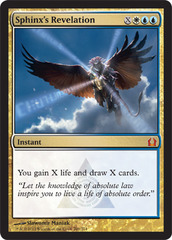
Raw card draw is the most common approach to card advantage taken by archetypical Control decks. Their plan is to trade resources repeatedly via removal spells, discard spells and counter magic, then refill with card draw spells. If they are able to do this successfully, they’ll run the opponent out of cards, then stick a lone threat and ride it to victory, whether that’s a planeswalker (Gideon, Ally of Zendikar/Jace, the Mind Sculptor), creature (Torrential Gearhulk/Aetherling), or even a sorcery (Approach of the Second Sun).
Card Destruction
If you consider card draw to be the positive way of getting ahead on cards, then card destruction is definitely the negative way. Destruction comes in many forms – mass removal:

Any time you are able to resolve a Wrath of God and destroy two or more of your opponents’ creatures (and none of yours), you’ve generated card advantage. While a Divination is certainly a two for one – your one card traded for two more – a Wrath can also be a two for one (or greater!), as you’ve traded your one card for two or more of your opponents. Wraths are another common tool of Control decks, but can also be commonly found in midrange decks, particularly after sideboard against more aggressive decks.
You may also find destruction in the form of discard:
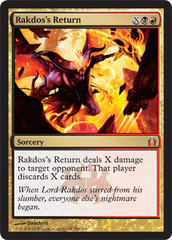
Mass discard effects can be very, very powerful. Timed correctly, mass discard spells can immediately trade for your opponents’ entire hand, completely throwing off their game plan! It’s difficult to plan ahead when you’re relying entirely on the top of your library, so cards like Rakdos’ Return can completely swing a game in your favour. Lastly, and on the topic of discard, you may recognise this innocuous planeswalker from Innistrad:
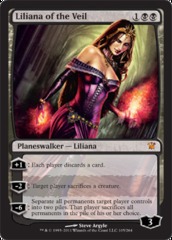
While mass discard effects can more or less end the game on the spot, repeatable discard effects – when unanswered – are likely to have the same effect (albeit in a slower and more demoralising way)! In this case, Liliana strips a card out of the opponents’ hand each turn. The instant she comes down, you are down a card, as her resolution achieves nothing in itself. However, one activation pays you back for casting her. The second gets you a two for one, the third a three for one… and so on. Both mass and repeatable discard effects are common inclusions in black-based midrange decks across multiple formats (looking at you, Liliana of the Veil. You too, Thoughtseize).
It’s worth noting that for all forms of card destruction, negatively affecting your opponents’ resources has diminishing returns, where benefitting your own tends not to. While you have a maximum hand size – your eighth card in hand at the end of your turn holds less value than the first seven – until you actually reach the point of decking, the additional card filtering is still beneficial. Discard and removal spells, however, cannot strip the opponent of resources they do not have!
Cantrips
Next up, we have a mix of both card draw and card destruction: cantrips.
Cantrips are cards which replace themselves immediately, usually with those magical three words: draw a card. While cantrips can describe cards that do this and only this: famous examples being Brainstorm, Serum Visions, or Ponder – for the purposes of this section, we’re looking at cards that cantrip as a secondary function.

Baleful Strix offers one key advantage over a straight draw spell or a clean destruction spell – versatility. If you heavily need to draw cards, it won’t help as much as a Divination, and if you really need to destroy creatures, it won’t help as much a Wrath of God, but as a Jack of all Trades it does both efficiently. By nature of the Strix having Deathtouch, outside of niche scenarios involving First or Double Strike, it will always trade for either a removal spell or a creature in combat. As it has also drawn a card – or cantripped – the majority of the time, you traded zero cards for one (though for ease of discussion, most players would still refer to this as a two for one). In a similar vein, we have a UR staple:
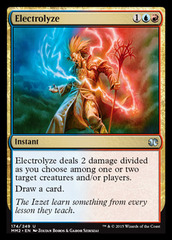
Electrolyze performs a very similar role to Baleful Strix, with a lower floor – sometimes, you’ll just need to throw it at your opponents’ head just to hit your land drop – but a higher ceiling, as if it nabs two creatures or planeswalkers, it got you a three for one; the same kind of card advantage enjoyed by Wrath of God or Ancestral Recall! Cantrips of all varieties are common across numerous formats due to their versatility, and turn many otherwise situational cards into main-deck staples.
Tricks
Lastly, we come to tricks. This is a Magic term often associated with pump spells or combat tricks. While these are an example of tricks, for the purposes of this section, a trick is any card that has the potential to trade for more than one even though it usually only trades for a single card. An example of a potential trick recently introduced in Aether Revolt:
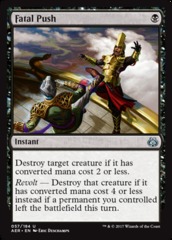
On the face of it, Fatal Push destroys one creature – one card. However, as an instant, it can be cast at any time. What if the opponent tries to enchant their creature with this?

If Destiny is on the stack and Push destroys its target, the Destiny will go to the graveyard along with the creature. All of a sudden, your spot removal spell became a two for one. Neat trick!
In a similar vein, let’s say your Siege Rhino is facing off against an Obstinate Baloth and a Dark Confidant. You could attack with the Rhino, have it be double blocked, and then assign damage to either creature, killing one of them but losing your Rhino. You could also cast your Fatal Push on Confidant, clearing the way for an attack with Rhino – an attack your opponent surely won’t block. Or, alternately, how about you attack first? Once the double block has been declared, that Push will clear the Confidant, and then the Rhino can beat up the Baloth. Your Push now traded for your opponent’s board!
There are many examples of potential tricks across numerous formats – how about your Counterspell hitting their Cathartic Reunion? Or your Blossoming Defense punishing a double block? The opportunities to land a trick are endless.
Note, however, that in all these examples your opponent had to make a double block, or cast an aura into open mana? The same goes for you! Be very cautious when attempting these kinds of plays, as a savvy opponent will always be looking for ways to get a two for one against you.
Summary
This article has been all about how to get ahead on cards, and as above, there are plenty of ways to do it; I haven’t even mentioned trading your large creature for their numerous small creatures in combat, or the myriad of other ways available to you as a player. That said, I hope this article has been illuminating, or for the more experienced player, helped solidify the ideas you knew instinctively.
Next week, we’ll be looking at virtual card advantage, and how it differs from raw card advantage. If you’ve any thoughts on the subject or if you have any questions, please leave them in the comments below. Good luck!





